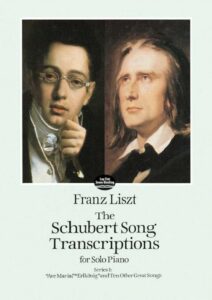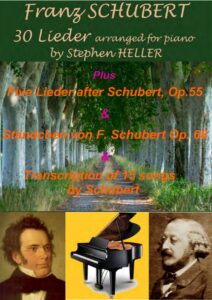Table of Contents
Come join us now, and enjoy playing your beloved music and browse through great scores of every level and styles!
Can’t find the songbook you’re looking for? Please, email us at: sheetmusiclibrarypdf@gmail.com We’d like to help you!
Schubert Piano Sonata Op. 42 (in A moll) sheet music, Noten, partitura, spartiti, partition, 楽譜
Please, subscribe to our Library.
If you are already a subscriber, please, check our NEW SCORES’ page every month for new sheet music. THANK YOU!

Best Sheet Music download from our Library.
Franz Schubert’s Piano Sonata in A minor, D. 845 (Op. 42), composed in 1825, is one of his most important and mature works for the piano. It is the first of his late piano sonatas and marks a significant step in his development as a composer.
Structure of the Sonata
The sonata consists of four movements:
1. Moderato (A minor)
– A solemn and dramatic opening with a rhythmic motif that pervades the movement.
– Schubert uses a theme-and-variations form in the development section, which was unusual for sonata-allegro form at the time.
– The movement is deeply expressive, alternating between lyrical tenderness and stormy intensity.
2. Andante, poco mosso (C major)
– A serene and lyrical movement with a theme and five variations.
– The variations explore different textures and moods, from delicate filigree to dramatic outbursts.
– The final variation returns to the simplicity of the theme, creating a sense of resolution.
3. Scherzo: Allegro vivace (A minor) – Trio (F major)
– A lively and rhythmic Scherzo with a playful, almost dance-like character.
– The Trio section provides contrast with a more lyrical and flowing melody.
– The movement showcases Schubert’s mastery of rhythmic drive and harmonic color.
4. Rondo: Allegro vivace (A minor → A major)
– A spirited and energetic finale with a rondo structure (ABACA).
– The main theme is bold and rhythmic, while the contrasting episodes provide moments of lyricism.
– The movement ends triumphantly in A major, resolving the tension of the sonata.
Key Features & Significance
– Harmonic richness: Schubert uses unexpected modulations and chromaticism, creating a sense of emotional depth.
– Structural innovation: The integration of variation techniques within sonata form was groundbreaking.
– Expressive contrasts: The sonata moves between melancholy, lyrical beauty, and dramatic intensity.
– Influence: This work foreshadows the even more expansive and profound late sonatas (D. 850, D. 894, D. 958-960).
Legacy & Performances
Schubert’s D. 845 is considered a masterpiece of the piano repertoire, admired for its depth and structural ingenuity. It has been recorded by many great pianists, including Alfred Brendel, Wilhelm Kempff, Mitsuko Uchida, and Paul Lewis.
Browse in the Library:
Or browse in the categories menus & download the Library Catalog PDF:
Schubert’s magical harmony

Schubert’s Piano Sonata in A minor, D. 845 (Op. 42) is a treasure trove of harmonic innovation, blending Classical form with Romantic expressiveness. Below is a detailed harmonic analysis of key moments in each movement, highlighting Schubert’s unique voice.
1. First Movement: Moderato (A minor) – Sonata Allegro Form
Exposition (mm. 1–93)
Main Theme (A minor, mm. 1–16):
Begins with a stark octave motif (A–E–A), harmonized with a Neapolitan (B♭ major, m. 5) for dramatic tension.
The second phrase shifts unexpectedly to C major (III, m. 9), a Schubertian “modal mixture” (borrowing from A major).
Chromatic bass descent (A–G♯–G–F♯–F–E) in mm. 13–16 foreshadows later developments.
Transition (mm. 17–32):
Modulates to C major (III) via a German augmented sixth chord (m. 24) resolving deceptively to C major’s dominant (G7).
Schubert avoids the expected E minor (v) for the second theme, opting for the brighter C major.
Second Theme (C major, mm. 33–52):
Lyrical and diatonic at first, but quickly destabilized by modal shifts (e.g., C minor inflections, mm. 41–44).
A sudden A♭ major (♭VI of C, m. 45) creates a mystical contrast before returning to C major.
Development (mm. 94–153)
Focuses on the octave motif, transposing it through F minor, D♭ major (enharmonic German sixth), and B minor.
A striking chromatic sequence (mm. 122–129) descends by minor thirds (B minor → G♯ minor → E minor → C major), dissolving into a diminished seventh before recapitulation.
Recapitulation (mm. 154–end)
The second theme now appears in A major (I) instead of the expected minor, but quickly darkens to A minor.
The coda (mm. 242–end) features a haunting pedal point on A with chromatic inner voices, ending in resigned stillness.
2. Second Movement: Andante (C major) – Theme and Variations
Theme (C major, mm. 1–16)
Simple diatonic harmony, but with subtle appoggiaturas and suspensions (e.g., m. 3: V7–I with a delayed resolution).
Variation 1 (mm. 17–32)
Broken chords in triplets, with a modal shift to C minor (m. 24) for a fleeting shadow.
Variation 2 (mm. 33–48)
D minor inflection (ii, mm. 37–40), then a Neapolitan (D♭ major, m. 41) for poignant contrast.
Variation 3 (mm. 49–64)
E♭ major (♭III) intrudes (m. 53), a “remote” key that Schubert connects seamlessly via commontone modulation.
Variation 4 (mm. 65–80)
Stormy C minor, with diminished seventh outbursts (mm. 73–76).
Variation 5 (mm. 81–96)
Returns to C major, but with chromatic passing chords (e.g., F♯°7 in m. 85) adding richness.
3. Third Movement: Scherzo (A minor) – Trio (F major)
Scherzo (A minor)
Hemiolas disrupt the 3/4 meter (e.g., mm. 29–30), while the harmony alternates between A minor and C major.
The Trio (F major) contrasts with a luminous, choralelike texture, but even here, Schubert inserts a D♭ major (♭VI) surprise (m. 118).
4. Fourth Movement: Rondo (A minor → A major)
Refrain (A minor, mm. 1–24)
Built on a driving rhythmic ostinato, harmonized with sudden shifts to C major (III) and E major (V/vi).
Episodes
First episode (C major, mm. 25–56): Features a folklike melody, but with chromatic descents (e.g., C–B–B♭–A in mm. 33–36).
Second episode (F major, mm. 89–120): A lyrical contrast, but with unexpected minorkey intrusions (F minor, m. 97).
Coda (A major, mm. 217–end)
The shift to A major feels earned, with the final chords alternating between A major and F♯ minor (vi), a bittersweet ambiguity.
Schubert’s Harmonic Hallmarks in This Sonata
1. Plagal (IV–I) and Neapolitan (♭II) Cadences: Used for solemn or mystical effects.
2. Chromatic Mediants: Sudden shifts to E♭ major (from C) or A♭ major (from C minor).
3. Modal Mixture: Borrowing chords from parallel major/minor (e.g., C major in A minor contexts).
4. Deceptive Resolutions: Dominant chords resolving to unexpected keys (e.g., V7 → ♭VI).

